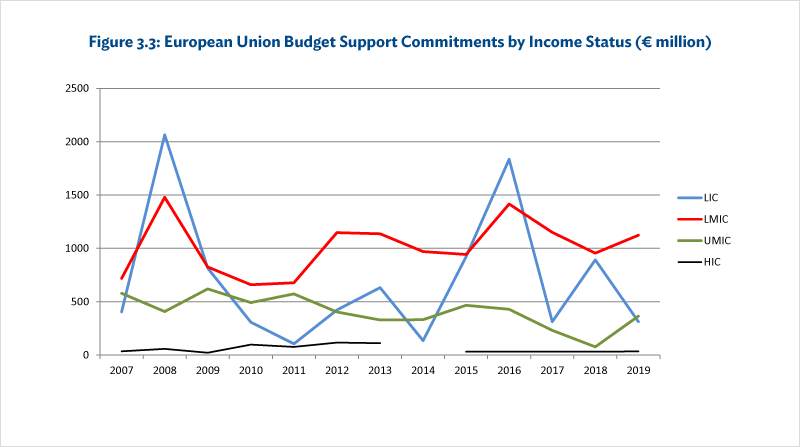Low-income countries (LIC) and lower middle-income countries (LMIC) are the primary beneficiaries of EU budget support, accounting for 81% of total commitments during 2007–2019. During 2007–2013, 23 LICs benefited from a total amount of €4.75 billion through budget support, with the largest amounts going to Burkina Faso, Tanzania, and Mozambique. During 2014–2019, 18 LICs received €4.4 billion, with the largest recipients being Burkina Faso, Afghanistan and Niger (each receiving €450–€500 million). As seen above and in Figure 3.2, countries in a fragile or crisis context have been increasingly important recipients of budget support since 2012.
Since a number of LICs have moved to LMICs status, the group benefiting the most from EU budget support has changed over time. During 2007–2013, 33 LMICS received budget support, of which Morocco, South Africa and Egypt received the highest amounts (between €500 million and €1.3 billion each over 2007–2014). During 2014–2019, 63 LMICs received budget support, with the highest amounts provided to Morocco, Tunisia and Ukraine.
Upper middle-income (UMIC) and high-income countries (HIC) were minor recipients of budget support. Most of the 36 UMICs and HICs benefiting from budget support during 2007–2013 were small-island states receiving budget support at the end of their trade protocol with the EU, which protected sugar production. During the more recent period 2014–2019, 14 HICs received budget support, with 70% of the amounts going to Eastern European states.

In terms of geographical areas, Africa remains the largest recipient of EU budget support, accounting for 60.4% of all budget support funding during 2014–2019 (€7.86 billion), followed by Asia and Eastern Europe (14% each) and Latin America (5%). The remaining 6% is accounted for by overseas countries and territories, and Caribbean and Pacific islands.
